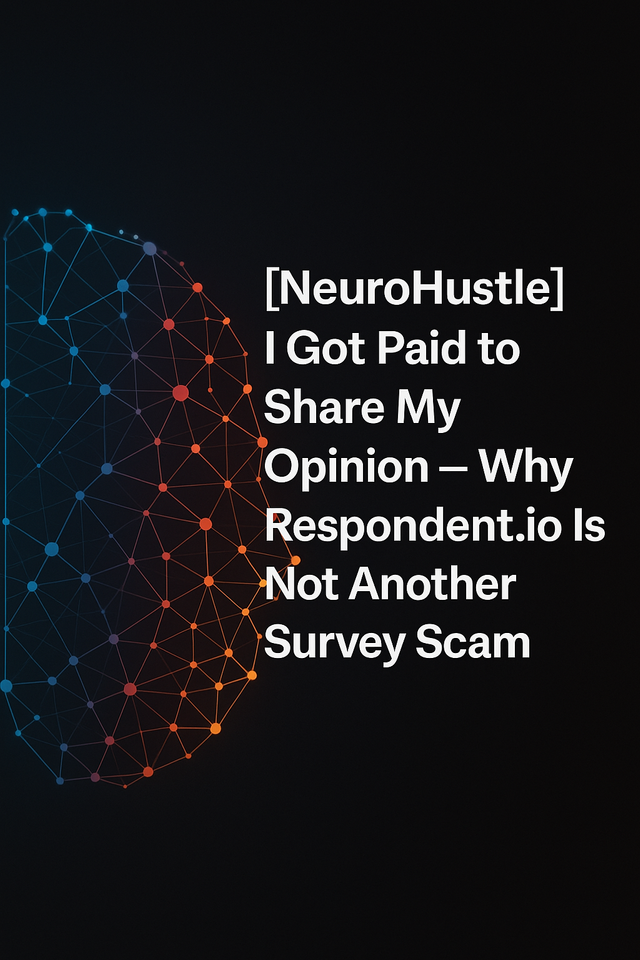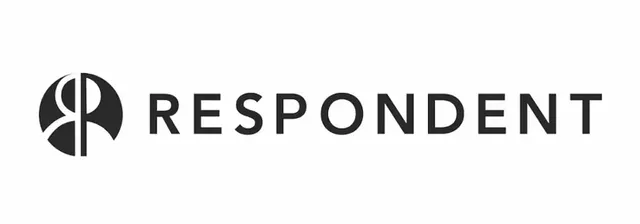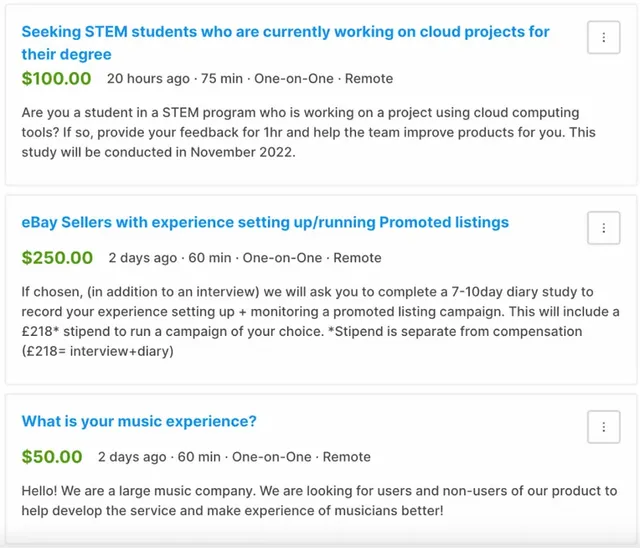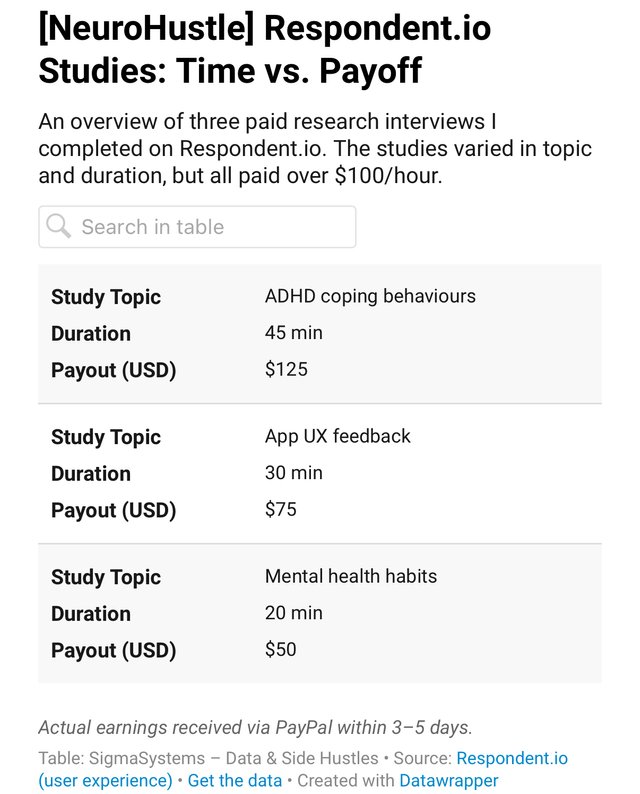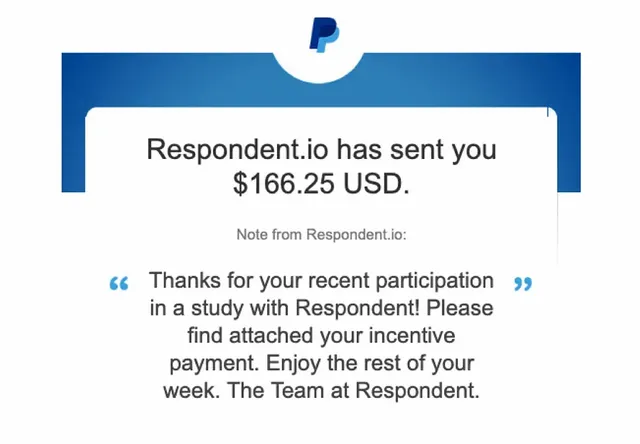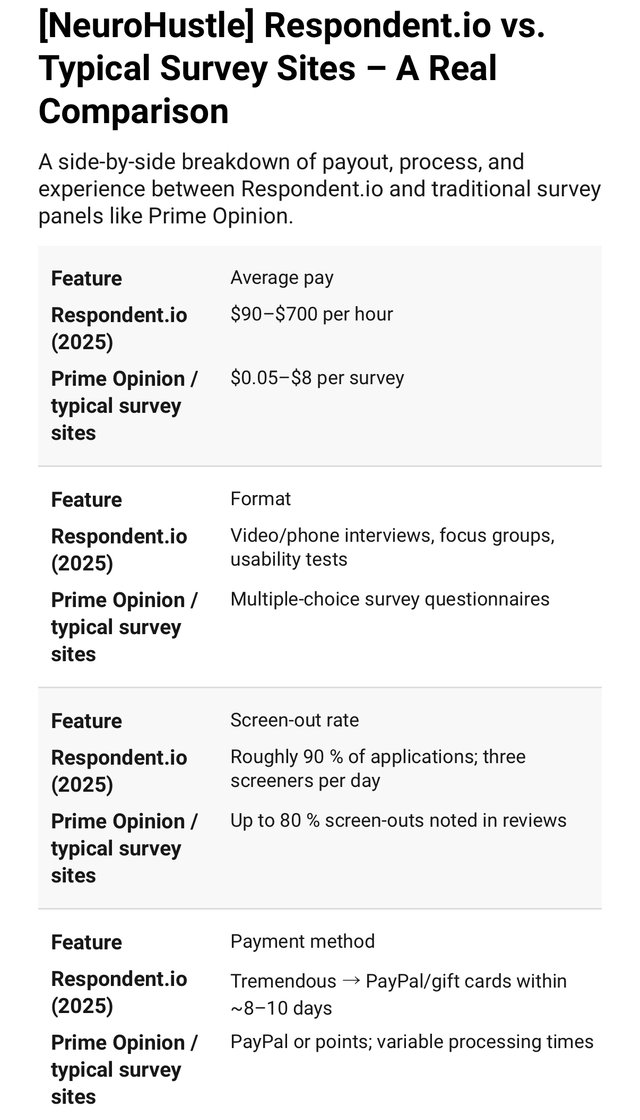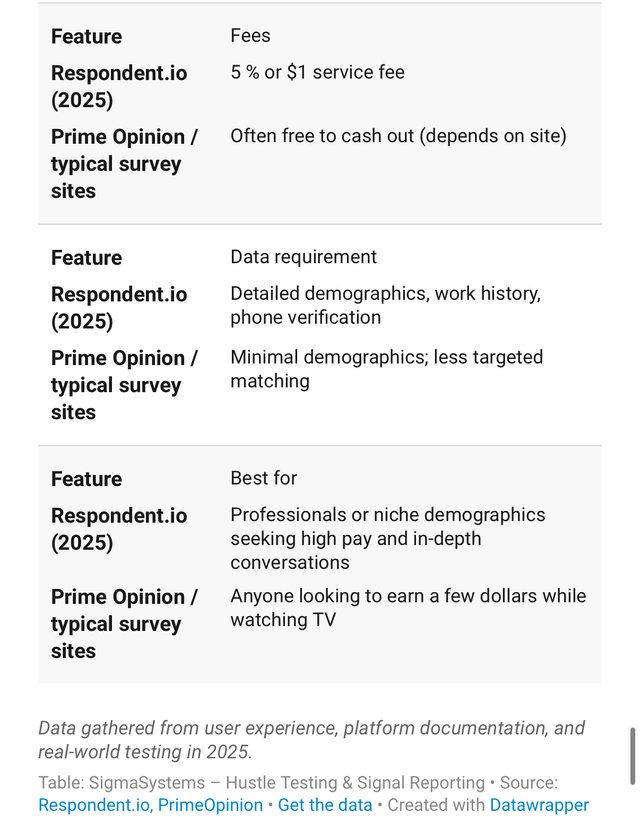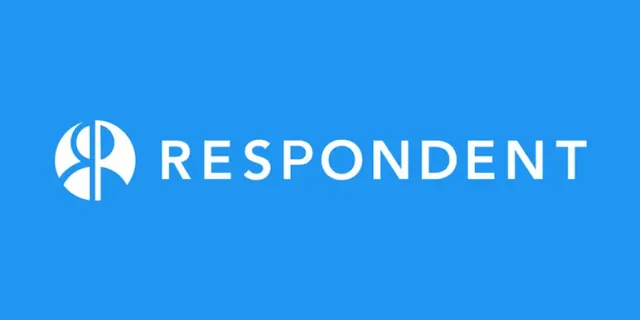[NeuroHustle] I Earned Over $100/hour Sharing My Insights – The Truth About Respondent.io
Hook / subtitle:
Tired of clicking through hundreds of 2‑cent surveys? I was too. Then I found a research platform that paid me like a professional and respected my time. Here’s everything I learned about Respondent.io – from sign‑up quirks to payouts, pro‑tips and pitfalls.
🧠 TL;DR
• Real Money: Respondent.io’s average project incentives range from about $90 to $700 per hour and many studies I applied to paid roughly $100 per hour . That is orders of magnitude more than micro‑survey sites where earnings are often a few cents per hour .
• Not Your Typical Survey: Studies are one‑on‑one interviews or focus groups rather than click‑through questionnaires . The site targets specific professional or demographic niches, which means fewer opportunities but far higher pay .
• Sign‑up & Screening: Joining is free. You can register with email or social login, fill out detailed demographics and verify your phone and LinkedIn. Only about 10 % of my applications turned into paid gigs – screeners filter heavily and you may only submit three per day .
• Payouts & Fees: Payments are issued via Tremendous and deposited to PayPal or gift cards. They usually arrive within 8 – 10 days, though some users report delays . A 5 % or $1 fee (whichever is higher) is deducted from each payout .
• Caveats: You will spend time filling out screeners and may face rejection for most studies. Some respondents on Trustpilot report payment issues or poor customer support . However, many more praise the fair compensation and user‑friendly interface .
🎯 Introduction – From 23 cents to $125 in 45 minutes
If you’ve ever dipped your toes into the world of online surveys, you know the pain: 300 questions later you’ve earned 23 cents and maybe a headache. I’ve been there. Like many readers of this column, I tried Swagbucks, Meinungsplatz, Toluna, LifePoints and Prime Opinion. These portals promised “easy money” yet delivered pennies and constant screen‑outs. Prime Opinion, for example, routinely screens users out of eight of ten surveys and offers pay between $0.05 and $8 per survey .
Searching for something better led me to Respondent.io – a platform built for user‑research rather than consumer polling. Unlike the points‑for‑gift‑cards model, Respondent promises cash for your expertise and lived experiences. Their website boasts over 3 million verified consumers and professionals across 150 countries and claims that researchers post around 4,000 studies each month . Intrigued, I signed up. This article chronicles my first weeks on Respondent.io and shares everything you need to know before diving in.
🔍 Why Respondent.io Is Different From Traditional Survey Sites
High‑paying interviews vs. click‑through questionnaires
Most survey apps pay a few cents per response because they rely on multiple‑choice questionnaires that take minimal effort. Respondent works differently: companies want depth, not quantity. Studies are typically:
• One‑on‑one interviews or moderated focus groups: These sessions are often conducted over Zoom or phone and can last 20 – 60 minutes . Some in‑person focus groups pay even more but require travel.
• Unmoderated usability tests: You might be asked to record yourself using a website or app. These sessions are still short but pay well because your reactions provide valuable qualitative feedback.
This methodology explains the eye‑catching hourly rates. Respondent encourages researchers to offer incentives of $90 – $200 per hour for general population studies and higher rates for specialists . In contrast, Prime Opinion’s surveys rarely top $8 .
Focused targeting leads to fewer but better‑paid opportunities
Respondent’s secret sauce is precision. The company uses demographics, professional information and behavioural targeting to match participants to studies . During sign‑up you provide gender, ethnicity, education, income, industry and job skills . This wealth of data allows researchers to recruit hard‑to‑reach audiences – which is why the payouts are high.
However, the flip side is that you won’t qualify for every study. The platform allows only three screener submissions per day , and being selected is competitive. In my case, roughly 10 % of applications turned into paid projects, echoing the experience described by Side Hustle Nation . In other words, you may fill out 30 screeners to land three interviews – but those interviews could be worth $100 or more each.
Professional & global scope
Respondent explicitly targets professionals such as developers, marketers, business owners and executives , but anyone over 18 can join . The platform supports participants in numerous countries including Australia, Brazil, Canada, France, Germany, India and South Africa . This global reach is why many of my studies involved international companies rather than local retailers.
✏️ Signing Up: Step‑by‑Step
Create your account. You can register with an email and password or use LinkedIn/Facebook to streamline verification . Respondent encourages linking social profiles because it reassures researchers that you are who you say you are .
Verify your identity. Upload a profile picture, enter your phone number and date of birth, and confirm your phone via SMS . This step weeds out fake accounts and increases your chances of selection.
Complete your demographic and professional profile. Be prepared to answer questions about gender, ethnicity, education, household income, city, employment status and job skills . The more detailed your profile, the more accurately you’ll be matched to relevant studies.
Agree to the code of conduct. Respondent requires participants to follow ethical guidelines. This includes showing up on time, being honest and not sharing confidential information.
Browse and apply. Once inside your dashboard you’ll see a feed of projects along with their payout, duration and format . Filter by payout, study type and whether it’s remote. When you find a study that fits, click Apply and complete the screener survey. Screeners take about five minutes and determine if you’re the right fit .
Wait and schedule. If a researcher selects you, you’ll receive an email/text invite to schedule your session. Be prompt; highly paid remote slots fill quickly.
Practical tips during sign‑up
• Connect your work email and LinkedIn: Verifying your professional credentials makes you more attractive to researchers and may unlock industry‑specific studies .
• Record an intro video: Respondent now lets participants upload a short self‑introduction. Think of it as a 30‑second elevator pitch explaining who you are and why your insights matter. According to user reports, this can increase your selection odds.
• Check daily: Respondent doesn’t always email new studies, so set a calendar reminder to log in regularly .
⚙️ Screening & Selection – Managing Rejection
Don’t expect to be chosen for every project. Respondent’s screeners are stringent; researchers want specific demographics and experience levels. Side Hustle Nation’s author notes that he was selected for only 5 projects out of 50 applications . Real Ways to Earn points out that you’re limited to three screeners per day , so pick wisely.
Why so many screen‑outs? Researchers pay high incentives and therefore narrow their criteria. As a result, you may spend time answering screener questions only to be rejected. This can be frustrating, but it ensures that when you are selected, the payout justifies the effort. By contrast, on Prime Opinion you’ll also face endless screen‑outs – the site’s review notes that users are screened out of eight of ten surveys – but the reward for qualifying is only a few dollars.
Strategies to improve your hit rate
• Be honest: Misrepresenting your profession or interests might get you into a study, but companies can tell when participants lack genuine experience. Answering screeners truthfully also saves you from being removed mid‑study .
• Prioritise relevance: Because you can only attempt three screeners daily, target studies that closely match your profile . Don’t waste a screener on a project for which you clearly don’t fit.
• Update your profile regularly: As your career and interests change, so should your Respondent profile. Adding new skills or life circumstances can open up new study categories.
• Respond quickly: Remote studies fill up fast. When you see a high‑paying project that fits, complete the screener immediately .
💸 What I Actually Earned
To test whether Respondent lived up to its promises, I applied to 27 studies over two weeks. Three projects accepted me. Here’s how the numbers shook out:
These figures are in line with what other participants report. Side Hustle Nation’s review calculates an overall hourly rate of about $102 based on multiple studies . Respondent’s guidance for general population projects suggests incentives between $90 and $200 per hour , while rates for specialists (e.g., medical professionals) can range from $250 to $1,000 per hour for remote work . Compared with typical survey platforms paying $0.50 – $2.00 for 15‑minute surveys , the difference is stark.
🧾 Payouts & Fees
How payments work
• Payment processor: Respondent uses Tremendous to facilitate payouts. You can choose a Visa gift card, various retail gift cards or a PayPal transfer .
• Timeline: Most users receive payment within 8 – 10 days after the study is marked completed . In my experience, two payments arrived on day 8 and one on day 11. The platform advises contacting support if you haven’t been paid after 10 days .
• Fees: Respondent deducts a 5 % service fee or $1 (whichever is higher) from your incentive . For example, my $125 session netted $118.75 after the fee. Fees are clearly shown on screener pages so you know the net amount before applying .
When things go wrong
Most reviewers praise the platform for prompt payments, but not everyone has a seamless experience. Trustpilot’s review summary notes that some users have reported denied compensation or lack of response from customer service . One reviewer described waiting over 60 days for payment after needing to update their PayPal email . Another complained about a study reward being cancelled without explanation . These anecdotes highlight the importance of keeping your PayPal account in good standing and promptly resolving any issues.
🎒 Pro Tips to Maximise Your Respondent Experience
Check the site frequently. New projects appear throughout the day and remote slots fill fast. Set reminders to log in at least every 24 hours .
Build a complete profile. Include your work history, education, household information and update it regularly . Linking social accounts and verifying your work email can boost your credibility .
Target high‑value studies. Use the filter options to sort by payout and time required . Focus on studies that match your expertise to increase your acceptance rate and hourly earnings.
Be punctual and professional. Treat interviews like a freelance job. Show up on time, dress appropriately (even on Zoom) and provide thoughtful answers. Researchers can rate participants, which may affect your future opportunities.
Use referrals wisely. Respondent pays $20 – $50 when someone you refer completes their first study . Share your link with friends who would genuinely fit the platform rather than spamming strangers.
⚖️ Pros & Cons at a Glance
Pros
• High pay: General studies pay roughly $90 – $200 per hour and specialist projects pay even more .
• Quality over quantity: Each study is meaningful; you aren’t wasting hours on mind‑numbing multiple‑choice questions.
• Global access: Participants from over 20 countries are eligible .
• Flexible scheduling: Many studies allow you to select a convenient time slot.
• Referral bonuses: Earn $20 – $50 when your referrals complete paid studies .
Cons
• Low acceptance rate: Expect to be chosen for about 10 % of the projects you apply for .
• Daily screener limit: You’re limited to three applications per day .
• Payment delays: While most payments arrive within two weeks, some users report extended delays or poor support .
• Personal data required: You must provide sensitive demographic and professional information during sign‑up .
📊 Respondent vs. Traditional Survey Sites (Prime Opinion as a Case Study)
🧠 Reflection – Why I’m Hooked & What’s Next
My first week on Respondent was both exhilarating and humbling. I earned more in three short sessions than I ever made completing hundreds of micro‑surveys. Yet I also spent hours filling out screeners that led nowhere. This isn’t a get‑rich‑quick scheme; it’s a precision‑driven marketplace.
What makes Respondent appealing to me as a neurodivergent hustler is the respect it shows for participants’ time and expertise. The platform treats you like a consultant, not a click‑bot. Each interview left me feeling heard and valued, and I learned about product design, mental health tools and even ADHD research along the way. The payouts funded my coffee habits and some of my biohacking experiments – far more satisfying than hoarding points for an Amazon gift card.
At the same time, the platform has growing pains. Payment delays and occasional unresponsive researchers are genuine concerns. I also worry about the volume of personal data collected, though this targeting is partly why the pay is high. As of July 2025, the company claims to have industry‑low fraud rates of 0.3 % and 98 % researcher satisfaction , yet some participants still fall through the cracks .
For me, Respondent will remain an occasional side hustle rather than a primary income stream. It complements my passion for exploring AI, biohacking and psychological resilience – themes I cover here under the NeuroHustle and ShadowPsych pillars. If you’re curious to try Respondent, go in with realistic expectations: apply consistently, don’t chase every screener, and treat every interview like a paid consultancy.
📣 Call to Action
If this exploration of Respondent resonates with you, follow my journey. I’ll continue sharing honest stories at the intersection of side hustles, neurodivergence and self‑optimization. Subscribe to my Substack for weekly insights on earning strategies and mental performance, or check out my digital collectibles on Zora. Your support helps me keep experimenting and reporting back.
Ready to dive in? Sign-up here! Using it won’t affect your payout, but it will send a small bonus my way. I only recommend what I use and trust.
👤 About the Author
SigmaSystems – NeuroHustle ⚙️
I’m a tech‑obsessed experimenter, blending biohacking, AI side‑hustles and radical self‑reflection. From battling addiction and ADHD to optimizing focus and income streams, I share unfiltered journeys so you can learn from my wins and mistakes. Follow me on Medium for more stories, explore my collectibles on Zora, and subscribe to my Substack for weekly deep dives.
